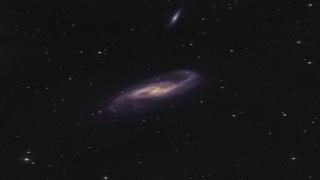Bibcode
de Swardt, B.; Sheth, Kartik; Kim, Taehyun; Pardy, Stephen; D’ Onghia, Elena; Wilcots, Eric; Hinz, Joannah; Muñoz-Mateos, Juan-Carlos; Regan, Michael W.; Athanassoula, E.; Bosma, Albert; Buta, Ronald J.; Cisternas, M.; Comerón, Sébastien; Gadotti, Dimitri A.; Gil de Paz, Armando; Jarrett, Thomas H.; Elmegreen, Bruce G.; Erroz-Ferrer, S.; Ho, Luis C.; Knapen, J. H.; Laine, Jarkko; Laurikainen, Eija; Madore, Barry F.; Meidt, Sharon; Menéndez-Delmestre, Karín; Peng, Chien Y.; Salo, Heikki; Schinnerer, Eva; Zaritsky, Dennis
Referencia bibliográfica
The Astrophysical Journal, Volume 808, Issue 1, article id. 90, 8 pp. (2015).
Fecha de publicación:
7
2015
Revista
Número de citas
7
Número de citas referidas
7
Descripción
We use mid-infrared 3.6 and 4.5 μm imaging of NGC 3906 from the
Spitzer Survey of Stellar Structure in Galaxies (S4G) to
understand the nature of an unusual offset between its stellar bar and
the photometric center of an otherwise regular, circular outer stellar
disk. We measure an offset of ∼910 pc between the center of the
stellar bar and photometric center of the stellar disk; the bar center
coincides with the kinematic center of the disk determined from previous
HI observations. Although the undisturbed shape of the disk suggests
that NGC 3906 has not undergone a significant merger event in its recent
history, the most plausible explanation for the observed offset is an
interaction. Given the relatively isolated nature of NGC 3906 this
interaction could be with dark matter substructure in the galaxy's halo
or from a recent interaction with a fast moving neighbor that remains to
be identified. Simulations aimed at reproducing the observed offset
between the stellar bar/kinematic center of the system and the
photometric center of the disk are necessary to confirm this hypothesis
and constrain the interaction history of the galaxy.
Proyectos relacionados

Las Galaxias Espirales: Evolución y Consecuencias
Nuestro grupo pequeño esta bien conocido y respetado internacionalmente por nuestro trabajo inovativo e importante en varios aspectos de la estructura y la evolución de las galaxias espirales cercanas. Usamos principalmente observaciones en varias longitudes de onda, explotando las sinergías que nos permiten responder a las cuestiones más
Johan Hendrik
Knapen Koelstra